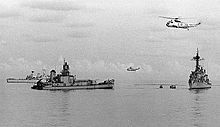- USS Frank E. Evans (DD-754)
-

USS Frank E. EvansCareer (US) 
Namesake: Brigadier General Frank Evans Builder: Bethlehem Steel, Staten Island Laid down: 21 April 1944 Launched: 3 October 1944 Commissioned: 3 February 1945 Struck: 1 July 1969 Honors and
awards:1 battle star (World War II)
5 battle stars (Korean War)Fate: Bow lost in collision with Australian carrier Melbourne. Stern recovered and sunk as target. General characteristics Class and type: Allen M. Sumner class destroyer Displacement: 2,200 tons standard, 3,218 tons full load Length: 376.5 feet (115 m) Beam: 41.1 feet (12.5 m) Draft: 14.2 feet (4.3 m) mean, 15.7 feet (4.8 m) maximum Propulsion: 60,000 horsepower (45 MW)
- General Electric geared turbines
- two screws
Speed: 36.5 knots (68 km/h) Range: 3,300 miles @ 20 kn (5,300 km @ 37 km/h) Complement: 336 Armament: 6 x 5-in (127 mm)/ 38 cal dual purpose guns (3x2),
12 x 40 mm guns,
11 x 20 mm guns,
10 x 21-inch (533 mm) torpedo tubes (2x5),
6 x depth charge projectors,
2 x depth charge tracksUSS Frank E. Evans (DD-754), an Allen M. Sumner class destroyer, was named in honor of General Frank Evans, a leader of the American Expeditionary Force in France during World War I. She served in late World War II and the Korean War, and Vietnam War before being cut in half in a collision with the Australian aircraft carrier Melbourne in 1969.
Contents
Construction
Her keel was laid down at the Bethlehem Steel Company shipyard in Staten Island, New York. She was launched on 3 October 1944 sponsored by Mrs. Frank E. Evans, widow of General Evans, and commissioned on 3 February 1945, with Commander H. Smith in command.
Service history
World War II
Frank E. Evans arrived at Pearl Harbor on 18 May 1945 for her final training, and crossed to Eniwetok, Guam, Ulithi, and Okinawa on escort duty. Reaching action waters on 24 June, she was assigned to radar picket and local escort duty, often firing on enemy aircraft. At the close of hostilities, she patrolled the Yellow Sea and the Gulf of Chihli, embarked released Americans from prisoner of war camps near Dairen, Manchuria, covered occupation landings at Jinsen, Korea, and continued to operate in the Far East until 6 March 1946 when she sailed from Tsingtao for San Francisco, California. Immobilized there on 31 March, Evans was decommissioned and placed in reserve on 14 December 1949.
Korean War
Recommissioned on 15 September 1950 for duty in the Korean War, Evans sailed from San Diego, California on 2 January 1951 for duty with the 7th Fleet. On 26 February, she began her part in the lengthy siege of Wonsan, during which she engaged enemy shore batteries eleven times. On 18 June, she was struck by 30 shrapnel hits, which caused minor wounds to four crewmembers before the destroyer silenced the enemy battery.
During this tour of duty, Evans also bombarded targets in the Songjin-Chongjin area, rescued downed aviators, and coordinated and controlled day and night bombing missions by United Nations aircraft. She returned to San Diego on 4 September 1951.
Evans sailed on 22 March 1952 for her second Korean tour, serving on patrol and bombardment duty along the coast of Korea and on the Taiwan Patrol before returning to her new home port, Long Beach, California, on 6 November 1952. Her tour in the Far East from 13 June to 20 December 1953 coincided with the Korean armistice, and was devoted primarily to patrol duty.
From 1954 to 1960, Evans completed five tours of duty in the Far East, as well as joining extensive training operations along the west coast and in the Hawaiian Islands, occasionally with Canadian naval ships.
From 1962 to 1963, the ship was the fictitious Appleby used in the NBC military comedy series Ensign O'Toole starring Dean Jones in the title role.
Vietnam
Collision with HMAS Melbourne
Main article: Melbourne-Evans collisionAt around 3 a.m. on 3 June 1969, between Saigon and Spratly Island, Evans was operating with the Royal Australian Navy in company with Melbourne which was at flying stations. Melbourne signalled Evans, then to port of the carrier, to take up the rescue destroyer position. The logical movement would be to turn to port and describe a circle taking up station on the carrier's port quarter. Inexplicably, instead of turning to port, Evans turned to starboard, cutting across Melbourne's bow, and was cut in half in the ensuing collision. Her bow section sank instantly, taking 74 of her crew with it. At the time of the collision Evans's captain was asleep. The officer of the deck (a junior officer who was not qualified to stand watch, having failed at his previous board) failed to notify him when he executed the station change, as required by the Commanding Officer's standing orders. Evans was stricken from the Naval Vessel Register on 1 July 1969. The stern section was sunk as a target in Subic Bay on 10 October 1969.
See also
- USS Hobson
- HMAS Voyager (D04)
Notes
References
- This article includes text from the public domain Dictionary of American Naval Fighting Ships. The entry can be found here.
- Hall, Timothy, 1982, HMAS Melbourne, Allen & Unwin, Sydney, ISBN 0-86861-284-7
External links
- history.navy.mil: USS Frank E. Evans
- navsource.org: USS Frank E. Evans
- hazegray.org: USS Frank E. Evans
- http://www.ussfee.org/
Categories:- Cold War destroyers of the United States
- Korean War destroyers of the United States
- Ships built in New York
- Maritime incidents in 1969
- Shipwrecks in the Philippine Sea
- Ships sunk in collisions
- United States Navy Hawaii-related ships
- World War II destroyers of the United States
- 1944 ships
- Allen M. Sumner class destroyers of the United States Navy
Wikimedia Foundation. 2010.

